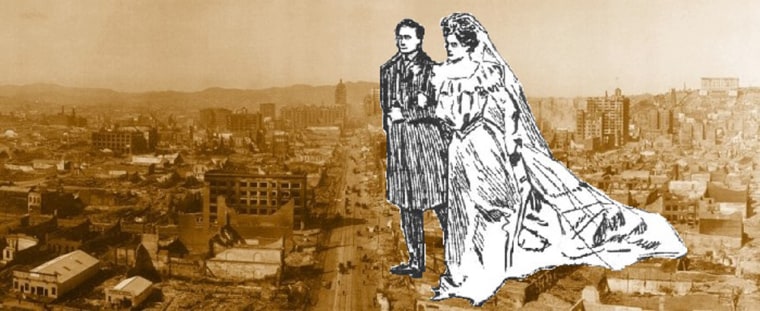On April 18, 1906, the earth moved in San Francisco. Then, for many San Franciscans over the following weeks and months, it moved again.
People from all walks of life lost their homes in the Great Earthquake of 1906. They were thrown together in refugee camps, on volunteer crews and in soup lines. It was spring. Cupid went to work.
“Marriage License Business Shatters All Records,” the San Francisco Bulletin reported two weeks after the earthquake. A San Francisco Call headline disclosed that in the month after the quake, “Number of Permits Granted Exceeded That Of Any Similar Period In History Of City.”
The San Francisco 1906 Earthquake Wedding Project has collected dozens of stories like this one, reported in The Oakland Tribune:
Love Smites Fleeing PairSEATTLE, May 2 — San Francisco’s awful earthquake and fire made refugees of Hal Smith and Miss Sadie Stearling, but in doing so brought them together in love and marriage. Having lost all their personal possessions, and fleeing with thousands of others from their respective homes in the stricken city, they met for the first time on the train speeding northward to Seattle.
It appears to have been a case on either side of love at first sight. Before the end of their journey they had become engaged, and yesterday were married by Judge Morris in his department of the Superior Court.
The project is the work of Pamela Storm Wolfskill and Ron Filion, who run SFGenealogy.com. As the centennial of the 1906 earthquake approached, their research kept turning up news reports about people who kept journeying from the ruins of their lives to the altar.
“We kept coming across all these interesting stories,” Wolfskill said. “You have to understand, in the papers then, all you were seeing was destruction and death and fire and damage — it was just so depressing. But you’d have these little sparks of humor and little mentions of Cupid at his tricks again.”
There’s the story of Giuseppe Alioto, who jumped onto a stranger’s boat at Fisherman’s Wharf. The boat belonged to Lorenzo Lazio, an Italian immigrant who ran a prosperous fish company. Lazio had a young daughter, Domenica Mae. “One day I shall marry her,” Giuseppe said. He did, eight years later.
Disaster As Aid To CupidDisaster has acted as an aid to Cupid, and since the holocaust, hundreds of people have secured marriage licenses in this city and been united in wedlock. Misery loves company, and the weddings result. In many cases the prospective bridegrooms have not had the needed sum of $2 to pay for the marriage license, but relief has been given them and all who have asked for a license have been accommodated.
— San Francisco Bulletin, April 23, 1906.
Records indicate that the marriage rate almost doubled in the months after the earthquake. And the accompanying babies, to a greater or lesser degree, would change the city forever.
The Aliotos, for instance, would have three daughters and one son. He was named Joseph. Joe Alioto would become mayor of the city in 1968, helping lead the way to the creation of BART, the Bay Area Rapid Transit system, and was briefly considered as a vice presidential running mate for 1968 Democratic presidential nominee Hubert Humphrey.
“All of these people, whether they’re famous or not, all had some kind of impact on history. The may consider themselves just an everyday person — nobody important — but their lives affect history and affect other people,” Wolfskill said.
Sentiment Amid Ruins. Marriages Resulting from Common Woe. By Harry C. Carr
By Direct Wire to the Los Angeles Times
SAN FRANCISCO, April 25—[Exclusive Dispatch] Fear lies chilly at my heart. Some female person will be sure to write a novel about this disaster. Romances are springing up on all sides.
The pattern has been repeated after disasters through time. Marriage and baby booms were documented after Sept. 11, 2001; the Oklahoma City bombing on April 19, 1995; the devastation of Hurricane Hugo on Sept. 25, 1989; and the South Asian tsunami of Christmas 2004. It’s too soon for reliable statistics to prove the point, but already, wedding vendors, bridal shops and caterers are reporting they can’t keep up with the demand after Hurricane Katrina.
Sociologists say people seek the stability of a family during times of stress. But the same stresses that lead people to the altar can also lead couples to their divorce lawyers. Catherine Cohan, a research associate at the Population Research Institute at Penn State University, who documented the marriage boom after Hugo, found a similar rise in the divorce rate in the Carolinas over the same period, driven there by financial pressures and reactions to stress.
And sometimes, the baby boom isn’t really one. After the Western power failures of August 2003, commentators predicted there would an explosion of births nine months later, because that’s what happened in New York City after the famous 1965 blackout.
In fact, they were wrong. As J. Richard Udry demonstrated in the August 1970 edition of the journal Demographics, there was no statistically significant difference in the birth rate in New York hospitals nine months after the blackout from the same period in the five previous years.
